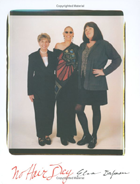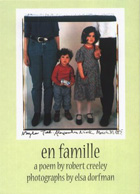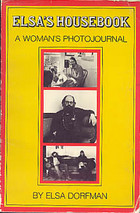Streetwise: Photographs
by Mary Ellen Mark
with an introduction by John Irving. Philadelphia, PA: University of Pennsylvania Press, 1988, 77 pp., $24.95 paper.
Mary Ellen Mark’s involvement with the runaway children of Pike Street in Seattle began in 1983 when she and Cheryl McCall, a Life magazine reporter, were assigned to do a feature story on the street kids in “America’s most livable city.” Mark, who has been a major photojournalist for the last twenty years, made these photographs when she, with Martin Bell and Cheryl McCall, was making the film Streetwise on which the book is based. She doesn’t explain whether these pictures were spliced into the film or if she took them to stand on their own; in any case, the interaction of the portraits and the edited soundtrack that accompanies them is very successful and puts this book in a class by itself. (I only wish that somewhere in the book it mentioned how to get hold of the movie.) There is much discussion among photography critics about the relationship of photographs and text, and many art photographers are combining text and images. I am not sure that purists would place Streetwise in this category because the text was actually created for the film. However, I think the images and text of the soundtrack work so well together precisely because the text is cinematic.
In his introduction, John Irving describes the movie as being as concrete and inevitable as a good novel. The same can be said for the book. I cared about the children when I looked at their portraits. The sense of hardship and waste of potential came to haunt me. The text made me marvel at the details of their difficult lives; it sent me back to study their portraits all over again.
The 57 portraits concentrate on Lulu, Rat, Mike, Shadow, Tiny, and Dewayne and their friends. Tiny’s mother, who is an alcoholic, is also central to the story. Lulu is nineteen:
She had been on and off the street since she was nine years old. She was gay, and at the time we met her she was involved in a difficult relationship with a girl named Wendy. Lulu was by far the most loved and respected person among the street kids. She was high strung and emotional and she had a major drinking problem, but she also had an extraordinary sense of justice.
Lulu was constantly defending the kids she felt had been done wrong. As a result she often fought with men and women much bigger or stronger than herself. She always gave them a good fight and most of the time she won, but as a result of her constant battles, she often had a black eye and a scarred and battered look. Sometimes she reminded me of a sad but feisty old alley cat. Lulu was an extraordinary character and Cheryl and I were immediately drawn to her. When Lulu decided that we were O.K. most of the kids accepted us. (p. ix)
Mark and McCall met Erin Blackwell in the parking lot of a Seattle discotheque called the monastery. “Tiny,” as she was known on the street, was almost fourteen, though she looked twelve. Once she was assured Mark and McCall were journalists, not the police, Tiny became friendly with them; eventually she became a major voice in the book. (Her portrait is on the cover.)
Rat and Mike lived in an abandoned building.
They introduced themselves as Rat and Mike and they were both sixteen years old. Rat looked more like a twelve-year-old and he was actually the leader of the two. Mike acted as his protector. The two boys were from Sacramento. They had run together after arguing with their families. They lived by begging, stealing, and eating from dumpsters. While searching for food in a dumpster Rat found a pair of roller skates, and he loved to skate up and down the hallways of the abandoned building. (p. x)
The book doesn’t have a story-line per se; it’s just a chronicle of a couple of months in these people’s lives. The portraits are honest and the trust each subject had for the photographer is obvious. It is not easy to make portraits that are as unself-conscious and unself-important as these are. The children seem very real and have lent themselves to Mark’s camera with great generosity, which she appears to have returned to them. (Mark is known, in fact, for her committed approach to her work and for her respect for her subjects. This book is consistent with her previous ones, Falkland Road, about the prostitutes of Bombay, and Ward 81, about a women’s ward in a mental hospital.)
The differences between At Twelve: Portraits of Young Women and Streetwise are overwhelming. Both have very high quality reproductions, but whereas Streetwise feels solid but modest in your hands, At Twelve is printed on a paper that feels absolutely creamy and sumptuous. Mary Ellen Mark seems to have had a goal at the same time more modest, more concrete and more ambitious than Sally Mann’s – simply to tell the story of some of the Pike Street children. By contrast, Mann’s murky notion of what she was looking for in the “transition to womanhood” and her cliched images of pubescent girlhood only succeeded in ruining her book.
Note: Streetwise was published in the summer of 1988; by January 1989, as this review was being prepared for publication, the University of Pennsylvania Press informed us that the book was already – after scarcely more than six months – been let go out of print, and that there are no plans to reprint it. We urge readers concerned about “disappearing” books like this one to call and write the publishers in protest.





